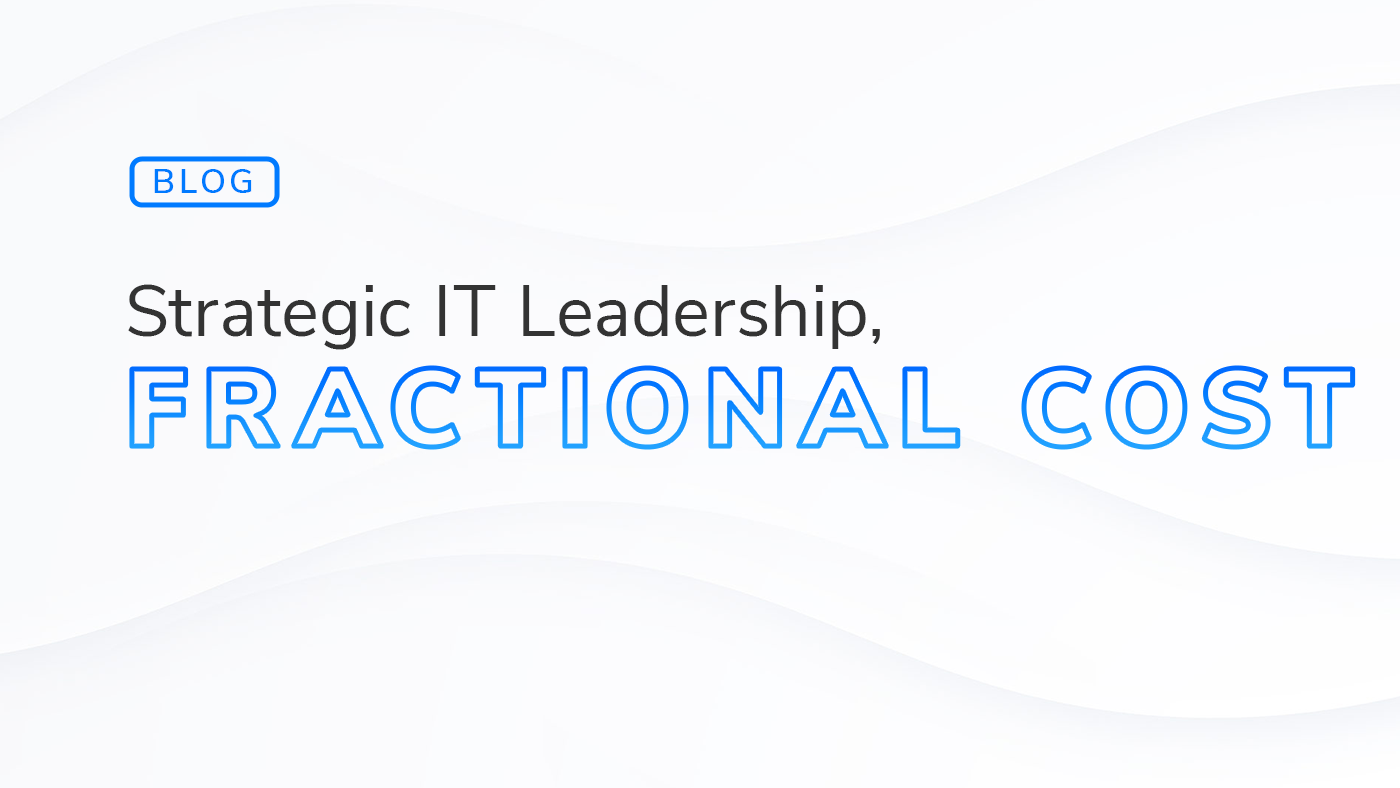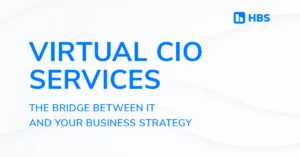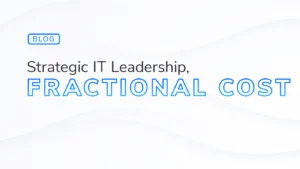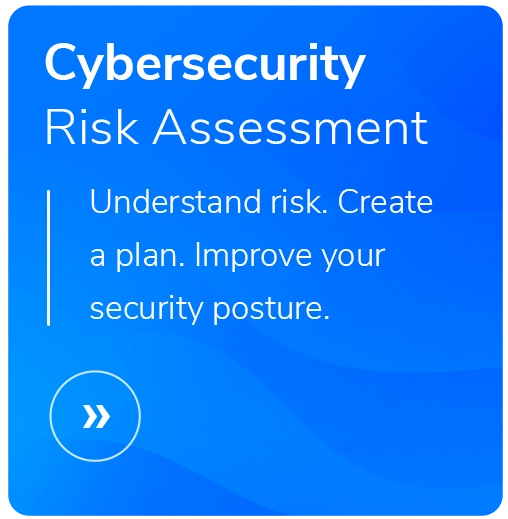Fractional IT Leadership: Smart, Strategic, and Scalable
- Chris Thurman, Director of Enterprise Optimization
- Read Time: 6 mins

Technology drives business success. Organizations of all sizes need to leverage technology to stay competitive. But not all—particularly small and medium-sized businesses—have the resources or the need to hire a full-time, senior IT executive.
Enter fractional IT leadership: a flexible, cost-effective way to access high-level IT expertise—e.g., a Chief Information Officer (CIO), Chief Technology Officer (CTO), IT director—without the full-time price tag.
In this article, we’ll explore the what, why, and how of fractional IT leadership—why it’s gaining traction, the value it delivers, and how businesses are using fractional IT services to stay competitive and secure.
Whether you’re refining your IT strategy or you’re a growing business needing expert leadership without the full-time price tag, fractional IT leadership helps you get the right expertise at the right time—without overextending your budget.
What Is Fractional IT Leadership?
Fractional IT leadership provides access to senior IT executives—CIOs, CTOs, IT directors—on a part-time, temporary, or contract basis. These leaders step in to develop IT strategy, oversee digital transformation, and strengthen cybersecurity, all while aligning technology with business goals.
Unlike consultants, fractional IT leaders become an integral part of your team. They provide ongoing strategic guidance, vendor management, and IT governance, working part-time, project-based, or during transitions—whatever best fits your business needs.
A fractional IT leader is particularly advantageous for businesses that do not yet need—or cannot afford—a full-time senior IT executive, but still require expert leadership to drive their tech strategy forward.
5 Reasons That Businesses Are Turning to Fractional IT Leadership
In the past, it was common for large corporations and enterprises to have a full-time CIO or CTO at the helm of their IT departments. However, the rise of fractional IT leadership has been largely driven by the changing needs of businesses in the digital age.
of Fortune 500 companies engage fractional executives
Now, companies of all sizes are rethinking traditional IT leadership. Here are some of their reasons:
1. Cost-Effective IT Strategy
Hiring a full-time CIO or CTO is expensive. A fractional IT leader provides the same expertise and leadership at a fraction of the cost—helping businesses allocate resources wisely while still benefiting from high-level strategic oversight.
Instead of paying for a full-time executive, organizations can engage a fractional IT leader only when needed.
2. Access to Expertise
Many fractional IT leaders bring decades of experience across industries. Whether you need cybersecurity oversight, cloud adoption, or IT modernization, a fractional leader bridges skill gaps and guides complex initiatives without long-term commitments.
These professionals have typically worked with organizations of varying sizes. They bring valuable experience managing complex IT environments and leading digital transformations.

3. Flexibility and Scalability
Need IT leadership for a specific project or ongoing advisory support? Fractional IT services scale with your needs. Businesses can engage these leaders for a set number of hours, or on a project-by-project basis.
This flexibility means that an organization can scale its IT leadership needs up or down as required. For instance, a business might need a fractional CIO to help with a specific digital transformation initiative and then reduce their involvement once the project is completed.
This ability to tailor the level of IT leadership engagement ensures that businesses can make the most of their budgets without overcommitting to a long-term hire.
4. Immediate and Long-Term Impact
Unlike full-time hires that require long onboarding processes, fractional IT leaders hit the ground running. They assess challenges, optimize technology investments, and provide actionable recommendations—delivering results faster.
In the long term, fractional IT leaders can help businesses develop a sustainable technology strategy that supports their overall growth objectives.
By offering both tactical and strategic expertise, fractional IT leaders can create long-lasting value that extends beyond any single initiative.
5. Bridging IT Leadership Gaps During Transitions
Leadership changes often create instability. Fractional CIOs and CTOs step in to minimize instability and better ensure continuity. Fractional leaders will keep systems and processes secure, and projects moving while organizations search for replacements or restructure their IT departments.
The Role of a Fractional IT Leader: 5 Key Responsibilities

Fractional IT leaders wear many hats.
Some of the roles they fill and how they drive value:
Strategic IT Planning
Fractional IT leaders craft technology strategies that align with business goals. They understand the importance of an IT strategic roadmap. They evaluate current systems, pinpoint gaps, and deliver a plan for future investments. Whether it’s upgrading infrastructure, adopting new software, or integrating technology for better efficiency, they ensure IT drives business forward.
Cybersecurity and Compliance Oversight
With cyber threats escalating, fractional IT leaders strengthen security postures. They implement risk management, compliance frameworks, and incident response strategies to better safeguard businesses from cyberattacks.
Driving Digital Transformation
As companies strive to stay competitive, many are undergoing digital transformation initiatives to modernize their operations. Fractional IT leaders can take charge of these initiatives, guiding businesses through the process of adopting new technologies, automating processes, and improving customer experiences. Their leadership helps ensure that digital transformation efforts are aligned with business objectives and achieve the desired results.

Vendor and IT Spend Optimization
Many businesses work with third-party vendors for software, hardware, and services. Fractional IT leaders help organizations manage these relationships, ensuring that vendors meet performance expectations and deliver value. They may also negotiate contracts, review service level agreements (SLAs), and manage vendor performance to ensure that the business gets the best possible service.
Cost optimization is a key responsibility of fractional IT leaders. They look for opportunities to optimize technology spending, whether it’s through more efficient use of existing tools or identifying cost-effective solutions. By leveraging their expertise, fractional IT leaders can help businesses get the most value out of their IT budget, avoiding unnecessary expenses and ensuring that resources are allocated appropriately.
IT Team Development and Leadership
Although fractional IT leaders are not full-time employees, they often oversee and mentor in-house IT teams. They provide leadership and direction to the team, ensuring that they are working effectively and efficiently. Fractional IT leaders help identify skills gaps within the team and may offer training or professional development to help employees grow.
Key Benefits of Fractional IT Leadership
- Cost Savings: Avoid full-time executive salaries while still getting top-tier expertise.
- Flexible Engagement: Scale IT leadership based on business needs and project scope.
- Senior-Level Expertise: Gain insights from seasoned IT executives without long-term commitments.
- Stronger IT & Cybersecurity Strategy: Ensure your technology investments align with business goals and security best practices.
- Business Growth & Innovation: Drive transformation without overextending internal teams.
When Should You Consider Fractional IT Leadership?
Fractional IT leadership is the right choice if:
- Your business is growing and needs scalable IT leadership, but can’t justify a full-time CIO/CTO.
- You need strategic IT direction and leadership, but only for a set period of time.
- You have specific projects that require high-level expertise, but don’t need a permanent hire.
- You have an IT team that needs mentorship and leadership.
- Your organization is undergoing a digital transformation and needs guidance.
The Future of IT Leadership Is Fractional
Agility, security, and smart technology investments define success. Fractional IT leadership is the modern solution for businesses that need IT expertise without long-term overhead. Whether guiding IT strategy, strengthening security, or driving innovation, fractional IT leaders help businesses thrive in a fast-changing tech landscape.
Need expert IT leadership without the full-time cost? A fractional IT leader from HBS might be the strategic advantage your business needs. Let’s talk.
Related Content

Virtual CIO
Enhance your IT-business alignment with the vCIO Services of HBS, offering strategic roadmaps, environment-wide assessments, and tailored strategies.

Fractional IT Leadership: Smart, Strategic, and Scalable
Get top-tier IT leadership without the full-time cost. Fractional IT leaders provide strategic planning, security oversight, and digital transformation expertise—on your terms.

Your Definitive Guide to Managed IT Services
Learn what Managed IT Services are and how they can help you save time and resources while improving your team’s productivity, efficiency, and security.






